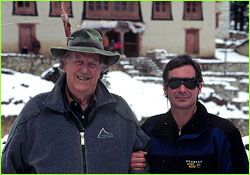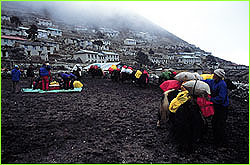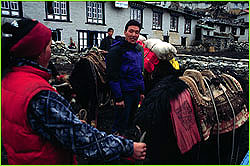
|
 |
 |
 From Sea Level to Base Camp
From Sea Level to Base CampPage 3 | Back to Page 2 A Visit From Sir Edmund Hillary When the weather is bad, the hum of a helicopter in the distance is generally a rare event in the Khumbu valley. But as we eat breakfast in Deboche we hear two helicopters circling overhead, trying to find a break in the mists surrounding Thyangboche. We hear that it's Ed Hillary, and Breashears instantly throws on his coat to hike up the hill and say hello. "It was Ed's photo of Tenzing Norgay on the summit of Everest in 1953 that inspired me to start climbing. It's a privilege to know Hillary today because of the lifetime he has devoted to improving the lives of the Sherpas of the Khumbu region with schools, bridges, airstrips and rebuilding monasteries." When we arrive at Thyangboche we find `Sir Ed' surrounded by a video camera crew conducting an interview with him. We wonder how often he has answered the same questions since he and Sherpa Tenzing Norgay made their historic first ascent of Everest in 1953. Continuing Up To Base Camp  Loading a yak takes three people, a lot of patience, and
either a coat of armor or good evasive movements. One yak will
carry two loads, each weighing about 50 pounds. The two loads
are hoisted simultaneously on either side of a yak by two
people as a third person holds the yak still—by the
horns. If one load is heavier than the other, it makes the
tying down process even harder.
Loading a yak takes three people, a lot of patience, and
either a coat of armor or good evasive movements. One yak will
carry two loads, each weighing about 50 pounds. The two loads
are hoisted simultaneously on either side of a yak by two
people as a third person holds the yak still—by the
horns. If one load is heavier than the other, it makes the
tying down process even harder.The last day of trekking to Base Camp is always the longest, but easily the most beautiful, with fleeting glimpses of the summit of Everest behind Nuptse and Everest's West Shoulder. Most of the day is spent traversing the Khumbu Glacier, a sea of churning ice and rock with massive blue ice pinnacles poised like a pod of frozen blue whales in the Khumbu's brown and white glacial waves. We're all anxious to get to Base Camp and stop the daily moving. Porters and yaks will be unburdened and sent back down the valley, and we can begin settling in to what will be our home for the next 40 days.  By the time we reach
Base Camp,
most of us have mild headaches. Heavy work—like digging
tent platforms out of the rock and ice of the Khumbu
Glacier—makes us breathless and tired. This year, Base
Camp is filled with some 400 prospective climbers, including
Sherpas, clients, guides, and support staff. The climbers are
from Malaysia, Indonesia, Japan, Scotland, USA, Canada, UK,
Russia, Sweden, Finland, Mexico, Italy, Spain, New Zealand,
and Nepal. "It's a remarkable transition from 1983 when we
were the only team on this side," says Breashears, "and it's
astonishing to me to meet dozens of people on the route whose
names you don't know."
By the time we reach
Base Camp,
most of us have mild headaches. Heavy work—like digging
tent platforms out of the rock and ice of the Khumbu
Glacier—makes us breathless and tired. This year, Base
Camp is filled with some 400 prospective climbers, including
Sherpas, clients, guides, and support staff. The climbers are
from Malaysia, Indonesia, Japan, Scotland, USA, Canada, UK,
Russia, Sweden, Finland, Mexico, Italy, Spain, New Zealand,
and Nepal. "It's a remarkable transition from 1983 when we
were the only team on this side," says Breashears, "and it's
astonishing to me to meet dozens of people on the route whose
names you don't know." Puja Two black Himalayan choughs (raven-like birds) balance precariously on top of the prayer flag pole, vying for top position above a twig of juniper. In the distance, the Khumbu Icefall spills down toward Base Camp, like giant ice cubes dumped from an Everest-sized ice bucket. The 26-year old lama continues his chants as Breashears, Jangbu, and the expedition Sherpas throw tsampa (a roasted barley flour) toward a stone altar covered with offerings of cookies, rice, popcorn, and beer. The puja ceremony, in which the Sherpas pay homage to the mountain deity, is the starting point for all Everest expeditions. Tomorrow, the climb officially begins and Breashears, Athans, Viesturs, Jangbu, and Carter will begin carrying loads up to Camp I at 19,000 feet. See Part II, the detailed story of our team's ascent to Camp II, or log on to our newsflashes for more regular updates from the field. Photos: (1-4) WGBH Educational Foundation; (5-10) Liesl Clark. Lost on Everest | High Exposure | Climb | History & Culture | Earth, Wind, & Ice E-mail | Previous Expeditions | Resources | Site Map | Everest Home Editor's Picks | Previous Sites | Join Us/E-mail | TV/Web Schedule About NOVA | Teachers | Site Map | Shop | Jobs | Search | To print PBS Online | NOVA Online | WGBH © | Updated November 2000 |